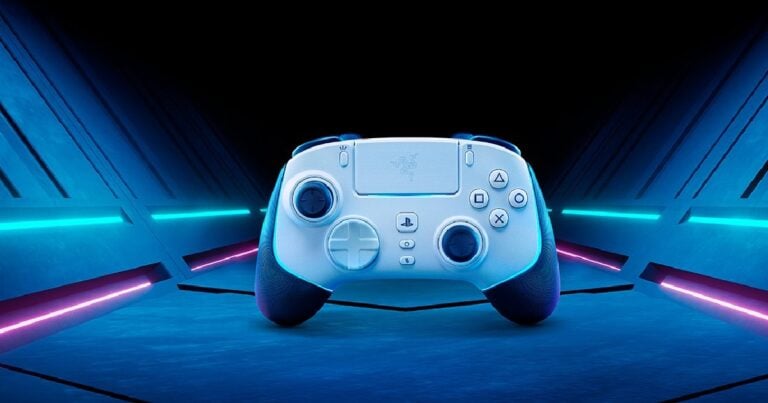Razer has just launched its premium PS5/PC controller, the Wolverine V2 Pro, so we go hands-on to see if it’s worth the price tag.
If there’s one things gamers love, it’s options. That may go some way to explain the increased popularity in speciality controllers over the last few years. From Xbox’s Elite to Sony’s DualSense Edge, the fight for controller dominance feels like it’s only just getting started.
Razer, on the other hand, would like to end the conversation entirely with its latest entry, the Wolverine V2 Pro. Available in either black or white colourways, it’s an incredibly sleek unit designed for use with both PS5 and PC via a USB dongle included in the box.
At first glance, the Wolverine V2 Pro mimics the look and feel of a regular Xbox controller, which should appeal to any Sony fans clamouring for offset analogue sticks. On the front of you have Razer’s Mecha-tactile action buttons, while on the underside there’s adjustable hypertriggers and four fixed back buttons. As you’d expect, almost any button can be re-configured to your heart’s desire using the Razer Controller App, while your thumbsticks can also be swapped out for a tall or short option. Razer has even managed to include its own signature RGB lighting near the grips, and I admittedly much prefer it to PlayStation’s own light bar.
Put everything together and the Wolverine V2 Pro feels study and weighty in the hand. It also features some of the best-feeling buttons I’ve ever used on a controller. The satisfying feedback and tension you get from using the device’s mecha-tactile buttons is second-to-none (especially for the face buttons and d-pad) and Razer should be commended for their implementation. The back buttons are slightly less ideal due to their permanency, however are totally usable once you get used to their placement – a smart call to avoid accidentally hitting them when not in use.
But while there’s a lot to love with the Wolverine V2 Pro, Razer has had to make some pretty big concessions by being a third-party offering. As a result, you won’t get access to The DualSense’s adaptive trigger technology or internal speaker. But while both of those can be overlooked, the lack of rumble is a much bigger omission and definitely changes the way games traditionally feel. Razer claims this is an intentional decision choice to remove the distraction of rumble – ideal for competitive play, but if you don’t fall within that camp it’ll be disappointing all the same.
That said, by lacking these features Razer can go big with its battery. The company claims the Wolverine V2 Pro can run for 10 hours with Chroma and a massive 28 hours without it. That seemed to be on the money during my testing, which absolutely outpaces the Edge’s meagre 5-hour capacity.
Admittedly the biggest hurdle the Razer Wolverine V2 Pro faces is its price. At $475.95 it’s one seriously expensive controller, and over $100 more than the DualSense Edge. It’s a unit that is incredibly niche in its target demographic, so just know what you’re getting into if you decide to pick one up. If you are looking to hop into the competitive scene, on the other hand, or want something with a mighty battery, the Wolverine V2 Pro might be hard to overlook.
You can buy the Wolverine V2 Pro from the Razer website.
Also out now…
Returnal (PC)
Despite being one of the few PS5 exclusive titles, Returnal doesn’t get nearly as much attention as it should. The roguelite supernatural shooter marked developer Housemarque’s best work and was one of the best games of 2021. Now the game is the latest Sony project to make its way to PC and if you still haven’t touched it, this port is just another incredible way to jump into the action.
Using a mouse for aiming, for example, provides great control over your weapons when compared to the DualSense and feels like an invaluable asset to intense combat encounters. Likewise, if you’ve got a rig powerful enough to run it at ideal settings, Returnal’s visuals positively shine, especially when countless projectiles start flying towards you.
Such intensity isn’t great news for everyone – the game not ideal for portable systems. The AYANEO AIR wasn’t really up for the task, and similar reports surround the Steam Deck, even at relatively low settings.
At the end of the day though, if you’ve got a machine up for the task, you owe it to yourself to try one of the quietest achievers of the last few years. Just be prepared for one hell of a challenge.
For more on this topic, follow the Gaming Observer.


































